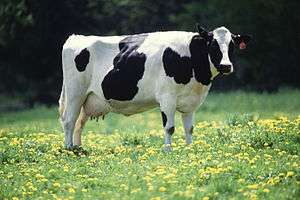Dairy cattle
Dairy cattle (also called dairy cows or milk cows) are cattle cows bred for the ability to produce large quantities of milk, from which dairy products are made. Dairy cows generally are of the species Bos taurus.[1]
Historically, there was little distinction between dairy cattle and beef cattle, with the same stock often being used for both meat and milk production. Today, the bovine industry is more specialized and most dairy cattle have been bred to produce large volumes of milk.
The United States dairy herd produced 83.9 billion kg (185 billion lbs) of milk in 2007, up from 52.6 billion kg (116 billion lbs) in 1950,[2][3] yet there were only about 9 million cows on U.S. dairy farms—about 13 million fewer than there were in 1950.[3] The top breed of dairy cow within Canada's national herd category is Holstein, taking up 93% of the dairy cow population, have an annual production rate of 10 257 kg of milk per cow that contains 3.9% butter fat and 3.2% protein.[4]
Management
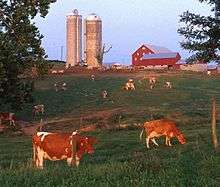
Dairy cows may be found either in herds or dairy farms where dairy farmers own, manage, care for, and collect milk from them, or on commercial farms. Herd sizes vary around the world depending on landholding culture and social structure. The United States has 9 million cows in 75,000 dairy herds, with an average herd size of 120 cows. The number of small herds is falling rapidly with the 3,100 herds with over 500 cows producing 51% of U.S. milk in 2007.[5] The United Kingdom dairy herd overall has nearly 1.5 million cows, with about 100 head reported on an average farm.[6] In New Zealand, the average herd has more than 375 cows, while in Australia, there are approximately 220 cows in the average herd.[7][8]
Pasteurization is the process of heating milk to a high enough temperature for a short period of time to kill the microbes in the milk and increase keep time and decrease spoilage time by killing the microbes, decrease the transmission of infection and eliminates enzymes that reduce the quality and shelf life Pasteurization is either completed at 63 °C for 30 minutes or a flash pasteurization is completed for 15 seconds at 72 °C.[9]
To maintain lactation, a dairy cow must be bred and produce calves. Depending on market conditions, the cow may be bred with a "dairy bull" or a "beef bull." Female calves (heifers) with dairy breeding may be kept as replacement cows for the dairy herd. If a replacement cow turns out to be a substandard producer of milk, she then goes to market and can be slaughtered for beef. Male calves can either be used later as a breeding bull or sold and used for veal or beef. Dairy farmers usually begin breeding or artificially inseminating heifers around 13 months of age.[10] A cow's gestation period is approximately nine months.[11] Newborn calves are removed from their mothers quickly, usually within three days, as the mother/calf bond intensifies over time and delayed separation can cause extreme stress on both cow and calf.[12]
Domestic cows can live to 20 years; however, those raised for dairy rarely live that long, as the average cow is removed from the dairy herd around age four and marketed for beef.[11][13] In 2014, approximately 9.5% of the cattle slaughtered in the U.S. were culled dairy cows: cows that can no longer be seen as an economic asset to the dairy farm.[14] These animals may be sold due to reproductive problems or common diseases of milk cows such as mastitis and lameness.[13]
Calf
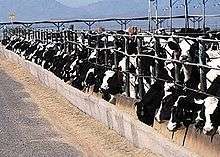
Market calves are generally sold at two weeks of age and bull calves may fetch a premium over heifers due to their size, either current or potential. Calves may be sold for veal, or for one of several types of beef production, depending on available local crops and markets. Such bull calves may be castrated if turnout onto pastures is envisaged, in order to render the animals less aggressive. Purebred bulls from elite cows may be put into progeny testing schemes to find out whether they might become superior sires for breeding. Such animals may become extremely valuable.
Most dairy farms separate calves from their mothers within a day of birth to reduce transmission of disease and simplify management of milking cows. Studies have been done allowing calves to remain with their mothers for 1, 4, 7 or 14 days after birth. Cows whose calves were removed longer than one day after birth showed increased searching, sniffing and vocalizations. However, calves allowed to remain with their mothers for longer periods showed weight gains at three times the rate of early removals as well as more searching behavior and better social relationships with other calves.[15][16]
After separation, some young dairy calves subsist on commercial milk replacer, a feed based on dried milk powder. Milk replacer is an economical alternative to feeding whole milk because it is cheaper, can be bought at varying fat and protein percentages, and is typically less contaminated than whole milk when handled properly. Some farms pasteurize and feed calves milk from the cows in the herd instead of using replacer. A day-old calf consumes around 5 liters of milk per day.
Bull
A bull calf with high genetic potential may be reared for breeding purposes. It may be kept by a dairy farm as a herd bull, to provide natural breeding for the herd of cows. A bull may service up to 50 or 60 cows during a breeding season. Any more and the sperm count will decline, leading to cows "returning to service" (to be bred again). A herd bull may only stay for one season since over two years old their temperament becomes too unpredictable.
Bull calves intended for breeding commonly are bred on specialized dairy breeding farms, not production farms. These farms are the major source of stocks for artificial insemination.
Milk production levels
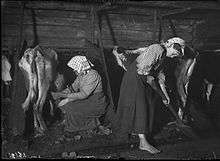
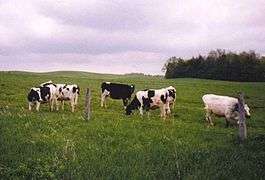
A cow will produce large amounts of milk over its lifetime. Certain breeds produce more milk than others; however, different breeds produce within a range of around 6,800 to 17,000 kg (15,000 to 37,500 lbs) of milk per lactation. The Holstein Friesian is the main breed of dairy cattle in Australia, and said to have the "world's highest" productivity, at 10000L of milk per year.[17] The average for a single dairy cow in the US in 2007 was 9164.4 kg (20,204 lbs) per year, excluding milk consumed by her calves,[2] whereas the same average value for a single cow in Israel was reported in the Philippine press to be 12,240 kg in 2009.[18] Production levels peak at around 40 to 60 days after calving.[19] The cow is then bred. Production declines steadily afterwards, until, at about 305 days after calving, the cow is 'dried off', and milking ceases. About sixty days later, one year after the birth of her previous calf, a cow will calve again. High production cows are more difficult to breed at a one-year interval. Many farms take the view that 13 or even 14 month cycles are more appropriate for this type of cow.
Dairy cows may continue to be economically productive for many lactations. In most cases, 10 lactations are possible. The chances of problems arising which may lead to a cow being culled are high, however; the average herd life of US Holstein is today fewer than 3 lactations. This requires more herd replacements to be reared or purchased. Over 90% of all cows are slaughtered for 4 main reasons:
- Infertility - failure to conceive and reduced milk production.
- Cows are at their most fertile between 60 and 80 days after calving. Cows remaining "open" (not with calf) after this period become increasingly difficult to breed, which may be due to poor health. Failure to expel the afterbirth from a previous pregnancy, luteal cysts, or metritis, an infection of the uterus, are common causes of infertility.
- Mastitis - a persistent and potentially fatal mammary gland infection, leading to high somatic cell counts and loss of production.
- Mastitis is recognized by a reddening and swelling of the infected quarter of the udder and the presence of whitish clots or pus in the milk. Treatment is possible with long-acting antibiotics but milk from such cows is not marketable until drug residues have left the cow's system, also called withdrawal period.
- Lameness - persistent foot infection or leg problems causing infertility and loss of production.
- High feed levels of highly digestible carbohydrate cause acidic conditions in the cow's rumen. This leads to Laminitis and subsequent lameness, leaving the cow vulnerable to other foot infections and problems which may be exacerbated by standing in faeces or water soaked areas.
- Production - some animals fail to produce economic levels of milk to justify their feed costs.
- Production below 12 to 15 litres of milk per day is not economically viable.
Cow longevity is strongly correlated with production levels.[20] Lower production cows live longer than high production cows, but may be less profitable. Cows no longer wanted for milk production are sent to slaughter. Their meat is of relatively low value and is generally used for processed meat. Another factor affecting milk production is the stress the cow is faced with. Psychologists at the University of Leicester, UK, analyzed the musical preference of milk cows and found out that music actually influences the dairy cow's lactation. Calming music can improve milk yield, probably because it reduces stress and relaxes the cows in much the same way as it relaxes humans. [21]
Cow comfort and its affect on milk production
Certain behaviors such as eating, rumination, and laying down can be related to the health of the cow and cow comfort.[22] These behaviors can also be related to the productivity of the cows.[22] Likewise, stress, disease, and discomfort will have a negative effect on the productivity of the dairy cows.[22] Therefore, it can be said that it is in the best interest of the farmer to increase eating, rumination, and laying down and decrease stress, disease, and discomfort to achieve the maximum productivity possible.[22] Also, estrous behaviors such as mounting can be a sign of cow comfort, since if a cow is lame, nutritionally deficient, or are housed in an over crowded barn, the performance of estrous behaviors will be altered.[23]
Feeding behaviors are obviously important for the dairy cow, as feeding is how the cow will ingest dry matter, however, the cow must ruminate to fully digest the feed and utilize the nutrients in the feed.[24] Dairy cows with good rumen health will likely be more profitable than cows with poor rumen health, as a healthy rumen will aid in the digestion of nutrients.[22] An increase in the time a cow spends ruminating is associated with the increase in health and an increase in milk production.[22]
Cows have a high motivation to lay down [24] so farmers should be conscious of this, not only because they have a high motivation to lay down, but also because laying down can increase milk yield.[25] When the lactating dairy cow lays down, blood flow is increased to the mammary gland which in return results in a higher milk yield.[25]
To ensure that the dairy cows lay down as much as needed, the stalls must be comfortable.[26] Put very simply, a stall should have a rubber mat, bedding, and be large enough for the cow to lay down and get up comfortably.[26] Signs that the stalls may not be comfortable enough for the cows are the cows are standing, either ruminating or not, instead of laying down, or perching, which is when the cow has its front end in the stall and their back end out of the stall.[26]
There are 2 types of housing systems in dairy production, free style housing and tie stall. Free style housing is where the cow is free to walk around and interact with its environment and other members of the herd. Tie stall housing is when the cow is chained to a stantion stall with the milking units and feed coming to them.[27]
By-products
By-products of milk include butterfat, cream, curds, and whey. Butterfat is the fat in milk. The cream is the yellowish part of the milk. The cream contains 18–40% butterfat. Whey is the watery part of the milk.
The industry can be divided into 2 market territories; fluid milk and industrialized milk such as yogurt, cheeses, and ice cream.[28]
Reproduction
Since the 1950s, artificial insemination (AI) is used at most dairy farms; these farms may keep no bull. Artificial insemination uses estrus synchronization to indicate when the cow is going through ovulation and is susceptible to fertilization. Advantages of using AI include its low cost and ease compared to maintaining a bull, ability to select from a large number of bulls, elimination of diseases in the dairy industry, improved genetics and improved animal welfare [29] Rather than a large bull jumping on a smaller heifer or weaker cow, AI allows the farmer to complete the breeding procedure within 5 minutes with minimum stress placed on the individual females body [29]
More recently, embryo transfer has been used to enable the multiplication of progeny from elite cows. Such cows are given hormone treatments to produce multiple embryos. These are then 'flushed' from the cow's uterus. 7-12 embryos are consequently removed from these donor cows and transferred into other cows who serve as surrogate mothers. The result will be between 3 and 6 calves instead of the normal single, or rarely, twins.
Hormone use
Hormone treatments are sometimes given to dairy cows in some countries to increase reproduction and to increase milk production.
The hormones are used to produce multiple embryos have to be administered at specific times to dairy cattle to induce ovulation. Frequently, for economic considerations, these drugs are also used to synchronise a group of cows to ovulate simultaneously. The hormones prostaglandin, gonadotropin-releasing hormone, and progesterone are used for this purpose and sold under the brand names Lutalyse, Cystorelin, Estrumate, Estroplan, Factrel, Prostamate, Fertagyl, Insynch, and Ovacyst. They may be administered by injection.[30]
About 17% of dairy cows in the United States are injected with Bovine somatotropin, also called recombinant bovine somatotropin (rBST), recombinant bovine growth hormone (rBGH), or artificial growth hormone.[31] The use of this hormone increases milk production from 11%–25%. The U.S. Food and Drug Administration (FDA) has ruled that rBST is harmless to people. The use of rBST is banned in Canada, parts of the European Union, as well as Australia and New Zealand.
In Canada, Canadian Dairy farmers have high screening procedures they have to go through every time the milk is retrieved from the farm; if the regulations are not met the milk does not get loaded onto the truck for further processing. There is to be no medication or hormones in the milk for safety reasons [9]
Nutrition
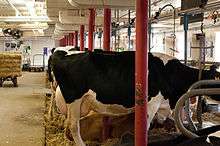
Nutrition plays an important role in keeping cattle healthy and strong.[32] Implementing an adequate nutrition program can also improve milk production and reproductive performance. Nutrient requirements may not be the same depending on the animal's age and stage of production.
Forages, which refer especially to hay or straw, are the most common type of feed used. Cereal grains, as the main contributors of starch to diets, are important in meeting the energy needs of dairy cattle. Barley is one example of grain that is extensively used around the world. Barley is grown in temperate to subarctic climates, and it is transported to those areas lacking the necessary amounts of grain. Although variations may occur, in general, barley is an excellent source of balanced amounts of protein, energy, and fiber.[33]
Ensuring adequate body fat reserves is essential for cattle to produce milk and also to keep reproductive efficiency. However, if cattle get excessively fat or too thin, they run the risk of developing metabolic problems and may have problems with calving.[34] Scientists have found that a variety of fat supplements can benefit conception rates of lactating dairy cows. Some of these different fats include oleic acids, found in canola oil, animal tallow, and yellow grease; palmitic acid found in granular fats and dry fats; and linolenic acids which are found in cottonseed, safflower, sunflower, and soybean.[35] It is also important to note that proper levels of fat also improve cattle longevity.
Using by-products is one way of reducing the normally high feed costs. However, lack of knowledge of their nutritional and economic value limits their use. Although the reduction of costs may be significant, they have to be used carefully because animal may have negative reactions to radical changes in feeds, (e.g. fog fever). Such a change must then be made slowly and with the proper follow up.[36]
Pesticide use
A survey of the primary dairy producing areas in the US indicated that 13 percent of lactating animals were treated with insecticides permethrin, pyrethrin, coumaphos, and dichlorvos primarily by daily or every-other-day coat sprays. Workers, particularly in stanchion barns, may be exposed to higher than recommended amounts of these pesticides.[37]
Breeds
According to the Purebred Dairy Cattle Association, PDCA, there are 7 major dairy breeds in the United States. These are: Holstein, Brown Swiss, Guernsey, Ayrshire, Jersey, Red and White, and Milking Shorthorn.[38]
Holstein cows have distinct white and black markings. Holstein cows are the biggest of all U.S. dairy breeds.
A full mature Holstein cow usually weighs around 1,500 pounds and is 58 inches tall at the shoulder. They are known for their outstanding milk production among the main breeds of dairy cattle. An average Holstein cow produces around 23,000 pounds of milk each lactation. Of the 9 million dairy cows in the U.S., approximately 90% of them are of the Holstein descent.[39] The top breed of dairy cow within Canada's national herd category is Holstein, taking up 93% of the dairy cow population, have a production rate of 10 257 kg of milk per cow that contains 3.9% butter fat and 3.2% protein[4]
Brown Swiss cows are widely accepted as the oldest dairy cattle breed, originally coming from a part of northeastern Switzerland. Some experts think that the modern Brown Swiss skeleton is similar to one found that looks to be from around the year 4000 B.C. Also, there is evidence that monks started breeding these cows about 1000 years ago.[40]
The Ayrshire breed first originated in the County of Ayr in Scotland. It became regarded as a well established breed in 1812. The different breeds that were crossed to form the Ayrshire are not exactly known. However, there is evidence that several breeds were crossed with the native cattle to create the breed.[41]
Guernsey cows originated just off the coast of France on the small Isle of Guernsey. The breed was first known as a separate breed around 1700. Guernseys are known for their ability to produce very high quality milk from grass. Also, the term "Golden Guernsey" is very common as Guernsey cattle produce rich, yellow milk rather than the standard white milk other cow breeds produce.[42]
The Jersey breed of dairy cow originated on a small island located off the coast of France called Jersey.[43] Being one of the oldest breeds of dairy cattle they now only occupy 4% of the Canadian National Herd [44] Being purebred and having genetic improved over 5 centuries Jersey cows, according to available data, have been in the UK area since about the year 1741. When they were in this area, they were not known as Jerseys, but rather as Alderneys. The period between 1860 and around 1914 was the best time for Jerseys. In this time span, many countries other than the United States started importing this breed, including Canada, South Africa, and New Zealand, among others.[45] a Jersey recently won the Senior Champion Female title for Jersey breed at the World Dairy Exposition in Wisconsin, US. Musqie Iatola Martha-ET was produced by Dillmans of Muquodobit in Nova Scotia [46] Among the smallest of the dairy breeds, the average Jersey cow matures at approximately 6699 kg, with a typical weight range between 800 and 1,200 pounds. Jerseys produce milk with approximately 5% butter fat and 3.80% protein.[44] This high fat content means the milk is often used for making ice cream and cheeses. According to the American Jersey Cattle Association, Jerseys are found on 20 percent of all US dairy farms and are the primary breed on about 4 percent of dairies. According to North Dakota State University, the fat content of the Jersey cow is nearly 5 percent—4.9 percent, to be exact. It's also the highest in protein, at 3.8 percent.[47]
Amongst the Bos indicus, the most popular dairy breed in the world is Sahiwal of the Indian subcontinent. It does not give as much milk as the Taurine breeds, but it is by far the most suitable breed for warmer climates. Australian Friesian Sahiwal and Australian Milking Zebu have been developed in Australia using Sahiwal genetics. Gir, another of the Bos Indicus breeds, has been improved in Brazil for its milk production and is widely used there for dairy.
Animal welfare
Animal welfare refers to both the physical and mental state of an animal, and how it is coping with its situation. An animal is considered in a good state of welfare if it is able to express its innate behaviour, comfortable, healthy, safe, well nourished, and is not suffering from negative states such as distress, fear and pain. Good animal welfare requires disease prevention and veterinary treatment, appropriate shelter, management, nutrition, humane handling, transport and eventually, humane slaughter.[48]
Proper animal handling, or stockmanship, is crucial to dairy animals' welfare as well as the safety of their handlers. Improper handling techniques can stress cattle leading to impaired production and health, such as increased slipping injuries. Additionally, the majority of nonfatal worker injuries on a dairy farm are from interactions with cattle. Dairy animals are handled on a daily basis for a wide variety of purposes including health-related management practices and movement from freestalls to the milking parlor. Due to the prevalence of human-animal interactions on dairy farms, researchers, veterinarians, and farmers alike have focused on furthering our understanding of stockmanship and educating agriculture workers. Stockmanship is a complex concept that involves the timing, positioning, speed, direction of movement, and sounds and touch of the handler. A recent survey of Minnesota dairy farms revealed that 42.6% of workers learned stockmanship techniques from a family members, and 29.9% had participated in stockmanship training. However, as the growing U.S. dairy industry increasingly relies on an immigrant workforce, stockmanship training and education resources will become more pertinent. Clearly communicating and managing a large culturally diverse workforce brings new challenges such as language barriers and time limitations.[49] Organizations like the Upper Midwest Agriculture Safety and Health Center (UMASH) offer resources such as bilingual training videos, fact sheets, and informational posters for dairy worker training. Additionally the Beef Quality Assurance Program offer seminars, live demonstrations, and online resources for stockmanship training.
The practice of dairy production in a factory farm environment has been criticized by animal rights activists. Some of the ethical reasons regarding dairy production cited include how often the dairy cattle are impregnated, the separation of calves from their mothers, and the fact that the cows are considered "spent" and culled at a relatively young age, as well as environmental concerns regarding dairy production.
The production of milk requires that the cow be in lactation, which is a result of the cow having given birth to a calf. The cycle of insemination, pregnancy, parturition, and lactation is followed by a "dry" period of about two months before calving, which allows udder tissue to regenerate. A dry period that falls outside this time frames can result in decreased milk production in subsequent lactation.[50] Dairy operations therefore include both the production of milk and the production of calves. Bull calves are either castrated and raised as steers for beef production or veal.
Animal rights groups such as Mercy for Animals also raise welfare concerns by citing undercover footage showing abusive practices at factory farms.[51]
See also
- Dairy cattle breeds
- Estrous synchronization
- Fog fever
- Dairy cattle showmanship
References
- ↑ http://www4.uwsp.edu/biology/facilities/vertebrates/Mammals%20of%20Wisconsin/Bos%20taurus/Bos%20taurus%20page.htm
- 1 2 U.S. Department of Agriculture, National Agriculture Statistics Service (March 2009). "Milk Cows and Production Estimates 2003-2007" (PDF). Retrieved 2011-01-30..
- 1 2 Blaney, Don P. (June 2002). "The Changing Landscape of U.S. Milk Production" (PDF). Statistical Bulletin Number 978, U.S. Department of Agriculture. Retrieved 2011-01-30.
- 1 2 http://www.dairyinfo.gc.ca/index_e.php?s1=dff-fcil&s2=mrr-pcle&s3=dcr-ebl
- ↑ James M. McDonald et al., "Changes in the Size and Location of U.S. Dairy Farms," Profits, Costs and the Changing Structure of Dairy Farming, ERR-47 Sept. 2007.
- ↑ "Milk and Milk Products, UK Dairy Industry," Department for Environment Food and Rural Affairs 3 Sept 2010.
- ↑ "New Zealand Dairy Statistics 2009-2010," Dairy NZ 2010.
- ↑ "Industry Statistics," Dairy Australia. Retrieved 5 Jan. 2011.
- 1 2 http://www.milkfacts.info/Milk%20Microbiology/Milk%20Microbiology%20Page.htm
- ↑ Department of Animal Science," Cattle Teaching and Research Center," Michigan State University 4 Nov. 2010.
- 1 2 Dewey, T. and J. Ng., "Bos taurus," Animal Diversity Web, 2001. Retrieved January 13, 2011.
- ↑ Dale More et al., "Calf Housing and Environments Series," Veterinary Medicine Extension Dec. 2010. Archived 1 September 2011 at the Wayback Machine.
- 1 2 Wallace, Richard L. (2002-03-13). "Market Cows: A Potential Profit Center". University of Illinois Extension. Retrieved 2011-01-30.
- ↑ U.S. Department of Agriculture, National Agriculture Statistics Service (April 2015). "Livestock Slaughter Annual Summary" (PDF). Archived from the original (PDF) on 12 September 2015. Retrieved 2015-11-24.
- ↑ Flower FC, Weary DM - Institute of Ecology and Resource Management, School of Agriculture, Edinburgh, UK. "Effects of early separation on the dairy cow and calf: 2. Separation at 1 day and 2 weeks after birth". Retrieved 2009-05-29.
- ↑ Stehulova,, I; Lidfors, L; Spinka, M (2008). "Response of dairy cows and calves to early separation: effect of calf age and visual and auditory contact after separation". Applied Animal Behaviour Science. 110: 144–165. doi:10.1016/j.applanim.2007.03.028. Archived from the original on 7 October 2009. Retrieved 5 February 2015.
- ↑ 'Holstein' (AUSTREX website). Accessed 2016-10-30.
- ↑ 12,000 liters milk per cow!, 2009 Archived 6 February 2012 at the Wayback Machine.
- ↑ Hutjens, Mike (1999-02-24). "Managing the Transition Cow". University of Illinois Extension. Retrieved 2011-01-30.
- ↑ Knaus (2009). "Dairy cows trapped between performance demands and adaptability". Journal of the Science of Food and Agriculture. 89 (7): 1107–1114. doi:10.1002/jsfa.3575.
- ↑ Relaxing music stimulates a cow's lactation http://uselessk.com/knowledge/relaxing-music-stimulates-a-cow-39-s-lactation/42
- 1 2 3 4 5 6 Vanhoudt, Van Winden, Fishwick, and Bell, 2015. Monitoring cow comfort and rumen health indices in a cubicle-housed herd with an automatic milking system: A repeated measures approach. Irish Veterinary Journal, 68(1), 368-762.
- ↑ O'Connor, 1993. Heat detection and timing of insemination for cattle.
- 1 2 Cooper, Arney, and Phillips, 2007. Two- or four-hour laying deprivation on the behavior of lactating dairy cows. J. Dairy Sci. 90, 1149-1158.
- 1 2 Haley, and Rushen, 2001. Assessing cow comfort: Effects of two floor types and two tie stall designs on the behaviour of lactating dairy cows. Applied Animal Behaviour Science, 71(2), 105-117.
- 1 2 3 Anderson, 2014. Dairy Cow Comfort - Free-stall Dimensions.
- ↑ http://dairyinfo.gc.ca/index_e.php%3Fs1=dff-fcil&s2=farm-ferme&s3=db-el
- ↑ http://dairyinfo.gc.ca/index_e.php?s1=dff-fcil
- 1 2 http://web.b.ebscohost.com/ehost/pdfviewer/pdfviewer?sid=d13c04f9-4d35-42eb-aea4-2097bb7e6b4e%40sessionmgr107&vid=1&hid=125
- ↑ David J. Miller. "Systematic Breeding Programs for the Dairy Herd" (PDF). Retrieved 5 February 2015.
- ↑ "Dairy 2007 Part II: Changes in the U.S. Dairy Cattle Industry, 1991–2007" (PDF). Animal and Plant Health Inspection Service. March 2007. Retrieved 2010-01-27.
- ↑ "Dairy cattle". Archived from the original on 7 June 2010. Retrieved 2010-06-02.
- ↑ "Feeding Barley to Dairy Cattle". Retrieved 2010-06-02.
- ↑ "Feeding Dairy Cattle for Proper Body Condition Score". Retrieved 2010-06-02.
- ↑ "Fats Defined". Retrieved 2010-06-02.
- ↑ "By-Products and Regionally Available Alternative Feedstuffs for Dairy Cattle". Retrieved 2010-06-02.
- ↑ Dr. David R. Pike - USDA Office of Pest Management Policy (January 2004). "Pest Management Strategic Plan For Lactating (Dairy) Cattle" (PDF). Retrieved 2009-05-29.
- ↑ "Purebred Dairy Cattle Association". Purebred Dairy Cattle Association. Purebred Dairy Cattle Association. Retrieved 17 September 2014.
- ↑ "Facts about Holstein Cattle" (PDF). Holstein Association USA Inc.
- ↑ "Breeds - Brown Swiss". The Cattle Site. Retrieved 2016-02-09.
- ↑ "Breeds - Ayrshire". The Cattle Site. Retrieved 2016-02-09.
- ↑ "Breeds - Guernsey". The Cattle Site. Retrieved 2016-02-09.
- ↑ http://www.ansi.okstate.edu/breeds/cattle/jersey
- 1 2 http://dairyinfo.gc.ca/index_e.php?s1=dff-fcil&s2=mrr-pcle&s3=mpb-plr
- ↑ "Breeds - Jersey". The Cattle Site. Retrieved 2016-02-09.
- ↑
- ↑ http://animals.mom.me/cows-highest-milk-fat-content-8041.html. Missing or empty
|title=(help) - ↑ Moran, John; Doyle, Rebecca (2015). Cow Talk. CSIRO Publishing. ISBN 9781486301614.
- ↑ Sorge, US; Cherry, C; Bender JB (16 May 2014). "Perception of the Importance of Human-Animal Interactions on Cattle Flow and Worker Safety in Minnesota Dairy Farms". Journal of Dairy Science. 97 (7): 4632–4638. doi:10.3168/jds.2014-7971. PMID 24835968. Retrieved 5 August 2016.
- ↑ Invited Review: Bovine Studies on Optimal Lengths of Dry Periods. Bachman & Schairer. 2002. j Dairy Sci. 86:3027-3037.http://dx.doi.org/10.3168/jds.S0022-0302(03)73902-2
- ↑ "Dairy's Dark Side: The Hidden Truth Behind Milk". Mercy for Animals. Retrieved 20 February 2014.
